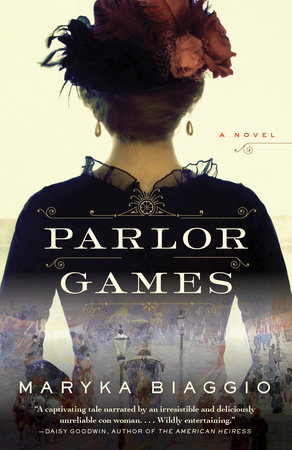READERS GUIDE
The questions, discussion topics, and suggestions for further reading that follow are intended to enrich your discussion of Maryka Biaggio’s
Parlor Games. Introduction
Based on a true story, comes a sweeping historical novel about a beautiful con artist whose turn-of-the-century escapades take her around the world as she’s doggedly pursued by a Pinkerton Agency detective.
The novel opens in 1917 with our cunning protagonist, May Dugas, standing trial for extortion. As the trial unfolds, May tells her version of events.
In 1887, at the tender age of eighteen, May ventures to Chicago in hopes of earning enough money to support her family. Circumstances force her to take up residence at the city’s most infamous bordello, but May soon learns to employ her considerable feminine wiles to extract not only sidelong looks but also large sums of money from the men she encounters. Insinuating herself into Chicago’s high society, May lands a well-to-do fiancé—until, that is, a Pinkerton Agency detective named Reed Doherty intervenes and summarily foils the engagement.
Unflappable May quickly rebounds, elevating seduction and social climbing to an art form as she travels the world, eventually marrying a wealthy Dutch Baron. Unfortunately, Reed Doherty is never far behind and continues to track May in a delicious cat-and-mouse game as the newly-minted Baroness’s misadventures take her from San Francisco to Shanghai to London and points in between.
The Pinkerton Agency really did dub May the “Most Dangerous Woman,” branding her a crafty blackmailer and ruthless seductress. To many, though, she was the most glamorous woman to grace high society. Was the real May Dugas a cold-hearted swindler or simply a resourceful provider for her poor family?
As the narrative bounces back and forth between the trial taking place in 1917 and May’s devious but undeniably entertaining path to the courtroom—hoodwinking and waltzing her way through the gilded age and into the twentieth century—we’re left to ponder her guilt as we move closer to finding out what fate ultimately has in store for our irresistible adventuress.
Questions and Topics for Discussion
1. In the first paragraph May says, “You and I, my new friend, will become well acquainted over the course of this tale.” How well do you think you really know May by the end of the novel?
2. At the end of the first chapter May explains, “I will tell you my story—all of it—and truthfully, as I’ve never been able to tell anyone before.” Is she always honest and, if not, what gives her away?
3. What do Frank’s letters imply about the nature of the relationship between her and May? Can we trust Frank’s portrayal of her relationship with May?
4. What kind of influence did May’s childhood have on her?
5. To what extent do you believe May’s actions were motivated by a desire to serve her family? And do you think May considers this a justification for her actions?
6. Do you believe May really loved any of the men she met during her travels? Did she ever find true love?
7. What does the yellow diamond necklace symbolize to May? What does it mean to you?
8. Were Pinkerton Detective Reed Dougherty charges of blackmail, spying, and extortion justified, or was he, as May contends, interfering in personal matters outside the province of the law?
9. Did May learn anything over the course of her adventures and trials? If so, what lessons did she learn?
10. At the close of the opening chapter, May exhorts the reader to hear her out and then be the judge. What is your verdict on May and her dealings with Frank and the men in her world?
About this Author
Maryka Biaggio, a former psychology professor, has many scholarly publishing credits to her name, but Parlor Games is her debut novel. Maryka loves the challenge of starting with actual historical figures and dramatizing their lives—imagining what motivated them to behave as the did, studying how the cultural and historical context may have influenced them, and recreating some sense of their emotional world through dialogue and action. She travels extensively, for both work and pleasure, is crazy about opera, and enjoys gardening, art films, and, of course, great fiction. She lives in Portland, Oregon, that edgy green gem of the Pacific Northwest.

